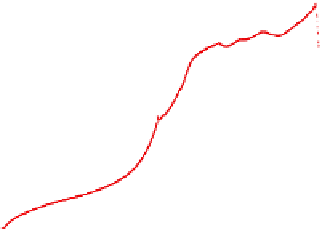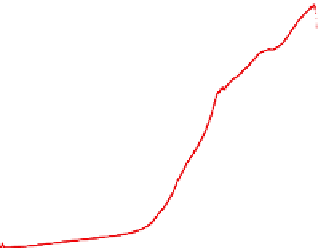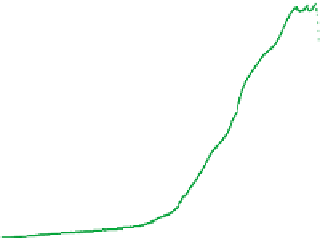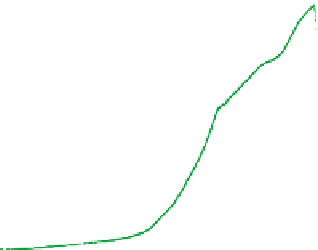Geology Reference
In-Depth Information
experimental set-up. The temperature traces were used to infer ignition, propagation rate, smoldering temperature,
oxygen dependence, and extinguishing characteristics.
The coal used in these experiments was Premium House Coal an anthracitic coal sourced from CPL Distribution,
UK. The true density was measured to be 1200
3%kg·m
3
.
+
The ignition protocol consisted of supplying the heater with a power of approximately 80W for 150 minutes. This
protocol was chosen as a strong ignition source minimizes sensitivity of the results to the ignition protocol and
allows ignition across a wide range of particle sizes.
The ignition and suppression experiments were undertaken as a function of the particle size of the coal. The
original coal particles were broken and sorted by measuring the longest side of the pieces. The particle size
ranges studied were 7
3mm, 10
5 mm, 15
5mm, 20
5mm, 30
5 mm, 30
10mm, 35
5mm, and
+
+
+
+
+
+
+
45
i.e. the volume not occupied by coal divided by
the total volume of the box, by filling a known volume with coal then using water to fill the voids to the same
level. The volume of water required is the void fraction. The void fractions for the samples studied ranged
from 54% to 61%.
5 mm. Void fraction was measured as the
“
free volume
”
+
Base Experiment
Before the experimental series is conducted, it is necessary to define an experimental protocol capable of providing
a repeatable smoldering fire. This led to the definition of the ignition protocol presented above. In order to ensure
the suppression results were independent of the ignition protocol used, the smoldering fire was allowed to develop
for a further 150 minutes after ignition before extinction was attempted. In this time, the fire was observed to have
spread throughout the entire sample mass prior to commencing the suppression.
Figure 18.1.3 shows the thermocouple traces and mass loss for a smoldering reaction carried out in the apparatus
using 30 mm particles. The ignition, steady burning and suppression regimes can be seen.
The temperature profile near the igniter is seen to be governed by the heat applied by the igniter until
approximately 120 minutes into the experiment where the sudden change in gradient indicates ignition in
this region. The reaction is then seen to propagate away from the igniter and the front reaches the thermo-
couple at 20mm at 150 minutes, 50 mm at 200 minutes, and 80mm at 250 minutes. The spread of a strong
smoldering front to 80mm away from the igniter after it has been switched off indicates that the fire is self-
sustaining. The maximum temperature observed was 840°C at 290 minutes into the experiment. The spread rate
can be calculated using the average temperatures in each location and the distance between them. The average
spread rate for 30mm particles is 0.11
0.3 mm·min
1
. At 300 minutes, the suppression is started and the
+
temperatures decrease rapidly.
Suppression started
900
Igniter off
800
Igniter
R1R
R1L
R2R
R2L
R3R
R3L
700
600
500
400
300
200
100
0
0
50
100
150
200
250
300
350
Time (min)
Figure 18.1.3. Temperature measurements vs. time for different locations in the sample. Base experiment for coal
particles of mean diameter 30 mm and suppression with a water spray. Black line is the igniter temperature, the red,
green and blue lines are temperatures 20, 50 and 80 mm from the igniter respectively.















































































































































































































































































